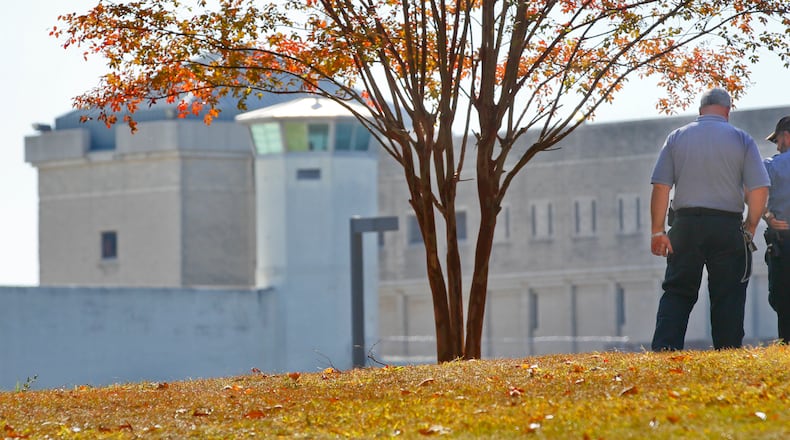Three men were in a vehicle parked outside the prison camp’s fence. When police spotted them, the men climbed the fence and escaped back into the camp. A search of the vehicle turned up bottled alcohol, 24 cellphones and two loaded handguns.
Inmates at the minimum-security prison camp adjacent to the U.S. Penitentiary in southeast Atlanta have been escaping for years through holes in the fence, but returning with contraband such as cellphones, cigarettes and possibly handguns, according to a federal complaint.
As far back as January 2013, the Atlanta Police Department has been investigating inmates “temporarily escaping from the prison camp … and frequently returning to the camp with contraband.”
» RELATED: Feds indict 51 in South Georgia prison cellphone scam
» RELATED: Feds' Georgia prisons sting leads to 49 arrests
Last month, after spotting a hole in the fence that was big enough for an adult man to get through, APD put a camera in place to record activity there and then turned the video over to the FBI, which has jurisdiction over the federal prison.
On the video, FBI Special Agent James Hosty wrote in a criminal complaint, the feds saw “inmates escape from the prison grounds” to retrieve large bags that they took back into the prison. Also, inmates would get into cars waiting for them on New Town Circle.
Last Friday, the FBI and local law enforcement were camped out when Justin Stinson escaped, according to the complaint filed on Saturday. Stinson was in prison for possession of a firearm by a prohibited person and was scheduled to be released Dec. 7, 2018. He now faces new charges of escape.
The FBI declined to comment because it is an ongoing investigation. The APD and the U.S. Bureau of Prisons also said they could not respond on Wednesday but may have answers to questions on Thursday.
The federal complaint filed Saturday, meanwhile, provides details of the constant flow of inmates escaping but returning within minutes with contraband such as cellphones, tobacco, alcohol and food that can be sold to other inmates, as well as potential weapons.
Cellphones pose a significant problem in state and federal prisons and in local jails because inmates use them to contact witnesses, to communicate with one another and to continue their criminal activities even while locked up.
“Since in or about January 2013, the Atlanta Police Department … has been investigating instances of inmates temporarily escaping from the prison camp at USP Atlanta and frequently returning to the camp with contraband,” Hosty wrote in the complaint.
The first example Hosty cited came when a police officer saw a car parked near the fence on Jan. 29, 2013. The people inside were wearing ski masks and gray jumpsuits.
“When APD stopped to investigate, three of the occupants climbed the fence and fled into USP Atlanta,” Hosty wrote.
Inside the car, the officer found “a large quantity of bottled alcohol, 24 cell phones and two loaded handguns.” There were several green Army bags near the prison camp’s fence line.
Near the holes in the fence along New Town Circle, which is lined with apartment buildings, APD officers found a prison-issued laundry bag, prison-issue gloves, an MP3 player and several trash bags outside the fence and near the holes.
No one has explained yet what transpired in the four years between that incident and Jan. 18, when the APD installed surveillance cameras in the area, which recorded inmates passing through the holes to retrieve large bags.
The FBI joined the surveillance, and on Feb. 3 around 9:20 p.m. Stinson went through a hole in one prison fence and then climbed a second fence on the outer perimeter, Hosty wrote in the complaint.
The inmate took a large black duffel bag from someone in a car parked on New Town Circle. The duffel bag contained a cellphone, scissors, two 1.75 liters of Jose Cuervo tequila, two cartons of Newport cigarettes, four boxes of Black and Mild cigars and food items.
The U.S. Penitentiary in Atlanta is a sprawling complex where Boulevard dead-ends into McDonough Blvd. At one time, it was a maximum security facility that held such high-profile criminals as Chicago mobster Al Capone.
The prison was scheduled to be closed in the late 1970s, but that plan was reversed when the United States needed a place to hold Cubans fleeing their island home. In late 1987, the 1,400 Cubans held there rioted and took 89 people hostage for 11 days after President Ronald Reagan’s administration announced it had reached a repatriation agreement with Cuba that would mean many detainees would be deported.
About the Author
The Latest
Featured

